The In-Between History of the Half-Up Hairdo
In Depth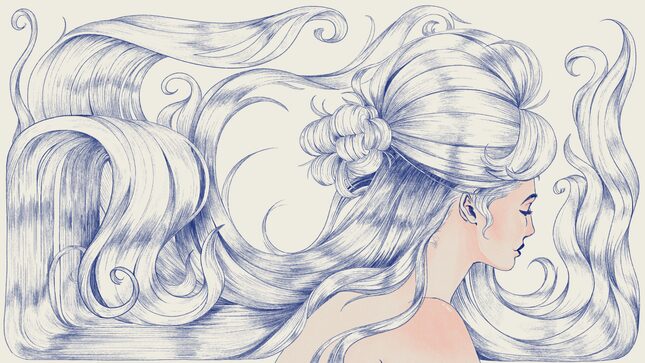
Illustration: Chelsea Beck
Evelyn Nesbit was scarcely a woman when she posed for Rudolf Eickemeyer Jr. for the first time. She was 16, maybe, or 17—the year of her birth is uncertain, and Evelyn didn’t know herself when she actually came of age. She had been modeling for years by that point anyway. She’d seen more of the world, and more of men, than most girls.
But she wasn’t really an adult woman, and that’s important because one of Eickemeyer’s photographs of Evelyn would go on to inspire an iconic artwork by Charles Dana Gibson, the creator of the world-famous Gibson Girl, titled “Woman: The Eternal Question.” In the photograph, Evelyn poses in profile, holding a white rose, her long eyelashes cast shadows on her cheeks, her face calm, her body swathed in heavy fabric, her hair loose yet pinned, up and down. In Gibson’s drawing, he tilted her chin up, removed her body, removed the flower, and left only her face and hair. The dark cascade of curls forms the shape of a question mark, a girl turned into a woman turned into a piece of punctuation.
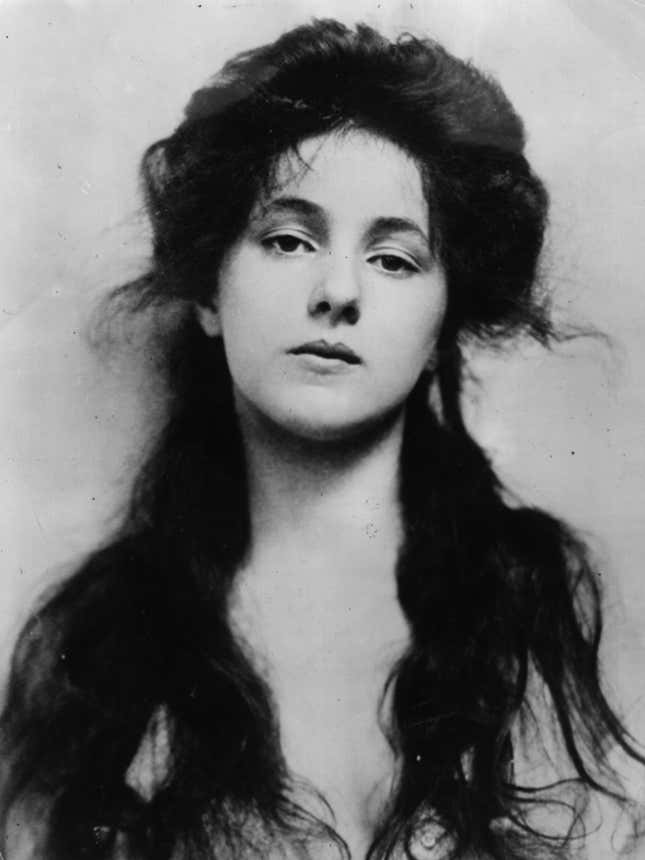
I love the first picture, like I love all of Eickemeyer’s photographs of Evelyn (or at least, all the ones I’ve seen). She was the original “It Girl,” lovely and lively, strong-minded and controversial. She was a model for artists and fashion designers, as well as a chorus girl, an actress, and much later, an art teacher. She lived most of her life on the edge of respectability—the men who paid for her image were respectable, as were the women who bought products featuring her likeness, but no matter how rich she married, she could never quite ascend into high society. Her story is a sad one, tainted with blood, tears, morphine, and murder; she’d become most famous as the woman stuck in the center of the sensational trial that ensued when her unstable husband shot and killed Gilded Age architect Stanford White, and Evelyn testified she’d been in a years-long relationship with White, which began when he drugged and assaulted the young model. In the early years of the 20th century, her expressive face was absolutely everywhere. I almost always love to see it, but I hate the Gibson picture. In that simple drawing, Evelyn is nothing but a question. Nothing but a bit of hair.
It’s her hair that does it, that turns her into a symbol, a mark on a page. Gibson’s women were all drawn like this—with big hair and simple features. Often, their hair was up in a chignon with just a few curls escaping. He drew his girls riding bicycles, playing croquet, and examining men under a magnifying glass. These women were big-haired and fine-featured, healthy and elegant. They were meant as a rebuke to the suffragettes, to all those women who wanted to be seen not as girls, but as humans.
Gibson was known for his fluffy-maned girls and Evelyn would come to be known for her pin-up portraits. In drawing the model this way, Gibson captured a bit of the zeitgeist. He also captured another question, one rendered in hair. When does a girl become a woman? When does an individual become an icon, an object?
The half-up, half-down hairstyle has become a preoccupation of mine recently because I find myself turning to it more and more, but not because I want to look younger. At 32, I’m a woman and I look it. No amount of clever styling will make me look like a teenager or like I’m on the cusp of anything save middle age. I’m using the supposedly “bombshell” look to hide my thinning hair. See, six months ago I had a baby. And after a woman has a baby, sometimes she loses a lot of hair, so much it clogs the drains. So much it collects in tumbleweed-like balls throughout her house. So much it annoys her dogs, even.
I find myself returning to a hairstyle I haven’t worn much since childhood, in efforts to disguise my newly limp locks. I’ve been twisting half of it back into a loose bun and securing it with a barrette, pulling the front and crown back in a miniature French braid, or making a small half-pony at the back of my skull. This isn’t like me; I’ve always preferred to do things whole hog. Hair up for workouts, up to cook, up to eat. Down to date, down to play with, down to sleep, down to dance. As I clipped my hair halfway back, I began to wonder about the hairstyle, and to wonder about Evelyn. I began to wonder what we see when we look at a woman’s hair, what we infer, what we know.
Almost 10 years ago, I worked as an intern for this very website, and one day an editor posted a graphic I found pretty funny. It was a picture of ponytails, and the height, it suggested, corresponded to the intelligence of the wearer. Low ponies were for serious thinkers. High ponies were for ditzy dummies. The commenters hated this post. The chart was misogynist, certainly. But I still found it funny—not because it was true, but because it was accurate. Like it or not, we do look at a person’s hair and make an assumption. We do use it as shorthand to figure out who they are. A high-and-tight on a guy in 2020 suggests certain political affiliations. Long gray hair on a woman suggests others.
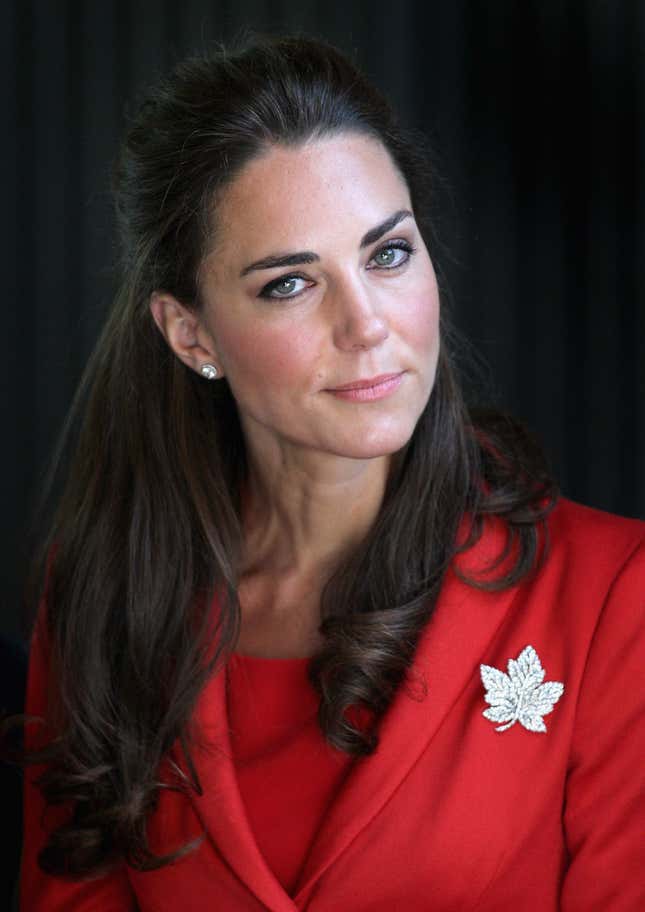
In the 21st century, e-girls wear their hair in sassy half-up pigtails; princess shiny-hair Kate Middleton inspires imitators with her half-up twisted locks; the Today Show reports on a Tweet about half-up gone wrong; and Cosmopolitan suggests screenshotting their entire slideshow about the look. Cosmopolitan says it’s a versatile look that is flattering on everyone, so long as you have long enough hair. It works with hair of all textures and thickness, and honestly, I think it looks good on people of all genders. By dividing the material and letting some hang, it creates an illusion of volume. It disguises the hairline. It makes you look a little done, but not too much. When I see someone with a half-do, I think they’ve put in a little effort.
Three hundred years ago, fashionable women in Europe and America all seemed to want the same thing I crave now—bigger hair. In the 18th century, voluminous hair was all the rage. The tightly curled shorter ringlets of the Regency Era weren’t yet en vogue, but it was no longer enough to have just a regular head of curls. Suddenly, everyone wanted touring messes of tresses, with just a few locks cascading down the back. You see this style frequently in French Rococo paintings and portraits, paired with low neckline dresses and big sleeves. Since many of us white women aren’t blessed with naturally big hair, the rich ladies of France, England, and America would often collect the loose hairs from their heads to make puffy removable tangles called “hair rats”—or they would simply purchase hair shorn from heads of peasants to add to their mounds. It was gross, in more than one way.
But for the most part, these Rococo looks weren’t true half-up dos. They were updos with a bit of flair, kind of like the ones girls wore to prom in the late 1990s (though instead of pulling out curls around the face, the 18th-century partygoers liked to pull out curls at the nape of their necks). It seems that the first real half-uppers came on the scene with the Pre-Raphaelites.
The Pre-Raphaelite woman was a very particular type of ideal. She was deathly pale. She had long, tumbling hair, often escaping from its loose bun or braids. She wore loose gowns that suggested the nude body underneath. She was shown out in nature, frolicking with fairies and scattering flowers in her wake. She was Ophelia, she was Persephone, she was Guinevere. She was tragic and very romantic. She was associated with nature, but not necessarily the wilderness. Her wild world was that of a garden. She was contained. She was possessed.
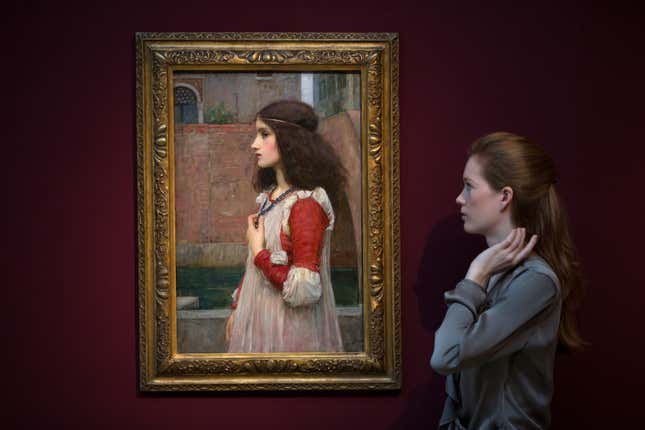
This brings us full circle, back to Evelyn Nesbit. She lived during a time where women were clawing a bit of power for themselves. Although she tried to assert her own will, Evelyn’s life was very much defined by the men who lusted after her, the men who hurt her. She seemed like the very picture of a certain type of old school femininity, one that was docile, accommodating, and soft. Here’s what she was not: she was not a suffragette, she was not an intellectual, and she was certainly not a flapper.
The visual opposite of a volume-enhancing updo is perhaps a buzz cut, but the flappers didn’t take it that far. They didn’t have to. Bobs were radical enough. They were so radical, in fact, that newspapers ran stories about bob-induced suicides with headlines like “Bobs Hair, Kills Herself” or “Hair Bob Causes Tragedy.” A girl would cut her hair, then regret it. Or her mom would be so devastated by how hideous her shorn daughter looked, she’d leap from a bridge. Can you imagine? It’s just hair.
But it wasn’t just hair. The bob rose to prominence after the First World War, a time when “the practicality and restraint of shorter hair came into its own,” writes Susan J. Vincent in Hair. “For women working in men’s job or nursing the wounded, or merely coping with the exigencies of a country plunged into conflict, its repudiation of a fulsome femininity came to strike the right note.” With the end of the conflict, some people thought women should leave the workplace and return to their former long-haired styles. After Armistice Day, a fashion forecast heralded the return of Edwardian beauty standards: “Women will become feminine again,” it said.
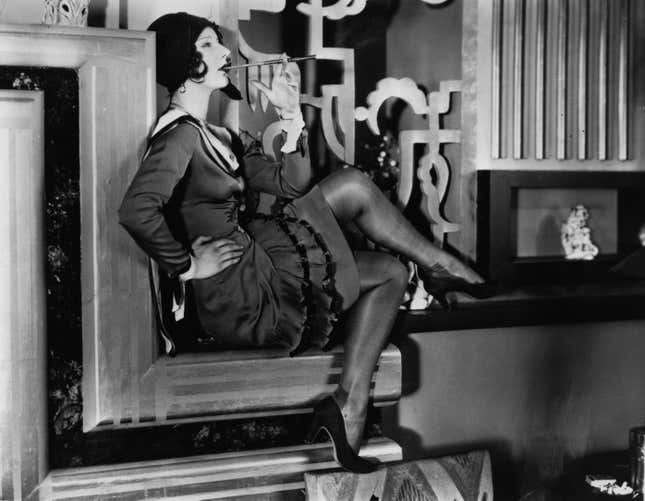
But some women didn’t want to become feminine again. American media could code the bob as queer, they could write about “bobbed bandits” and other dangerous renegades, but they couldn’t glue the hair back on the head. People tried. Some employers attempted to forbid female employees to wear their hair short (including the Salvation Army) and an evangelist in Belfast warned churchgoers never to marry a girl with short hair, but not even the power of god’s mouthpieces could stop the spread of the bob. “What the women immediately before and after the First World War did was to establish something much bigger than a real fashion—they forged a change in dress practices,” concludes Vincent. During this time, Gibson and others were trying to convince women to turn back the clock by presenting images of women performing femininity in a particular way. But once a definition expands, it is hard to make it contract again. Once we begin to truly see the beauty in other forms, it’s hard to remember why we resisted.
And yet, we can’t get rid of cultural norms entirely—it takes hundreds of years for aesthetics to truly change. The more I read about Gibson girls, the less I want to look like one. And yet, I sort of do. No matter how much I intellectualize it, I can’t stand the process of losing so much hair. I want my hair to be big and lush, not flat and straggly. I’m unable to fully detangle the association between long hair and femininity. So I wait until this phase passes and my follicles begin to produce anew. I wait, and I pin it up, and I cut it short, and I remind myself over and over: it doesn’t matter. It’s just hair.